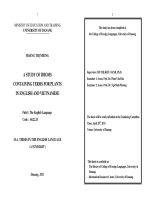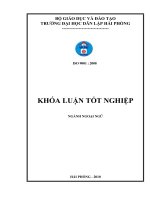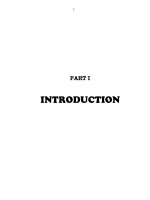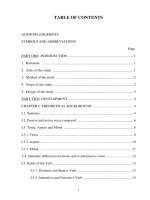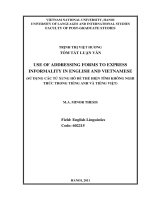A Cognitive Study of Metaphors Based on Human Senses in English and Vietnamese (Luận án tiến sĩ)
Bạn đang xem bản rút gọn của tài liệu. Xem và tải ngay bản đầy đủ của tài liệu tại đây (3.31 MB, 271 trang )
MINISTRY OF EDUCATION AND TRAINING
THE UNIVERSITY OF DANANG
TRẦN THỊ THÙY OANH
A COGNITIVE STUDY OF METAPHORS BASED
ON HUMAN SENSES IN ENGLISH AND VIETNAMESE
DOCTORAL THESIS
IN SOCIAL SCIENCES AND HUMANITIES
Danang - 2018
MINISTRY OF EDUCATION AND TRAINING
THE UNIVERSITY OF DANANG
TRẦN THỊ THÙY OANH
A COGNITIVE STUDY OF METAPHORS BASED
ON HUMAN SENSES IN ENGLISH AND VIETNAMESE
Major: English Linguistics
Code: 62.22.02.01
DOCTORAL THESIS
IN SOCIAL SCIENCES AND HUMANITIES
Supervisors: 1. Dr. Trần Quang Hải
2. Prof. Dr. Nguyễn Văn Hiệp
Danang - 2018
i
STATEMENT OF AUTHORSHIP
Except where reference is made in the text of the thesis, this thesis contains no
material published elsewhere or extracted in whole or in part from a thesis by which I
have qualified for or been awarded another degree or diploma.
This thesis has not been submitted for the award of any degree or diploma in any
other tertiary institution.
Danang, January 2018
Tran Thi Thuy Oanh
ii
ABSTRACT
The thesis studies English and Vietnamese conceptual metaphors based on the five
basic human senses namely vision, hearing, touch, smell and taste. The study uses the
descriptive, analytic, synthetic, qualitative, quantitative, comparative, contrastive,
deductive and inductive methods. The research finds out 19 conceptual metaphors from
setting up the mappings or sets of correspondences between the source domains and
target domains for each sense with the explanation in each situation. At the same time,
this work points out the similarities and differences between the two languages. Most of
conceptual metaphors can be found in both languages, but some are unique to
Vietnamese or English. The study also examines source domains sharing target domains.
Moreover, the “cross-expressions” between human senses in expressing language are also
clarified. The study suggests the implications for teaching, learning and translating
English in the view of cognitive linguistics in general and conceptual metaphor theory in
particular.
.
iii
LIST OF ABBREVIATIONS
CD
conceptual domain
CL
Cognitive Linguistics
CM
conceptual metaphor
CMs
conceptual metaphors
CMT
conceptual metaphor theory
HSs
human senses
ME
metaphorical expression
SD
source domain
OALD
The Oxford Advanced Learning Dictionary
TD
target domain
VD
The Vietnamese Dictionary
iv
TABLE OF CONTENTS
STATEMENT OF AUTHORSHIP............................................................................ i
ABSTRACT .............................................................................................................. ii
LIST OF ABBREVIATIONS .................................................................................. iii
TABLE OF CONTENTS ......................................................................................... iv
LIST OF TABLES……………………………………………………………….viii
LIST OF FIGURES ................................................................................................... x
CHAPTER 1. INTRODUCTION ............................................................................. 1
1.1. Rationale ....................................................................................................................... 1
1.2. Aims of the Study ......................................................................................................... 3
1.3. Objectives of the Study ................................................................................................. 4
1.4. Research Questions ....................................................................................................... 4
1.5. Scope of the Study ........................................................................................................ 4
1.6. Significance of the Study .............................................................................................. 6
1.7. Organization of the Study ............................................................................................. 6
CHAPTER 2. LITERATURE REVIEW .................................................................. 8
2.1. Cognitive Linguistics .................................................................................................... 8
2.1.1. The concepts of Cognitive Linguistics ................................................................... 8
2.1.2. Main tenets in Cognitive Linguistics .................................................................... 10
2.2. Conceptual Metaphor .................................................................................................. 11
2.2.1. The views of Conceptual Metaphor ...................................................................... 11
2.2.2. Related concepts ................................................................................................... 15
2.2.2.1. Conceptual domain .......................................................................................... 15
2.2.2.2. Source domain ................................................................................................. 16
2.2.2.3. Target domain .................................................................................................. 16
2.2.2.4. Mappings.......................................................................................................... 16
2.2.2.5. Conceptualization ............................................................................................ 18
2.3. Human senses.............................................................................................................. 19
2.3.1. The concepts of human senses ............................................................................... 19
2.3.2. Vision ..................................................................................................................... 20
v
2.3.3. Hearing .................................................................................................................. 21
2.3.4. Touch ..................................................................................................................... 22
2.3.5. Smell ...................................................................................................................... 23
2.3.6. Taste ....................................................................................................................... 23
2.4. Metaphor in literature ................................................................................................. 24
2.5. Related research .......................................................................................................... 25
2.5.1. A general review .................................................................................................... 25
2.5.2. The typical related works in English ..................................................................... 28
2.5.2.1. The work of Lakoff and Johnson...................................................................... 28
2.5.2.2. The work of Sweetser ....................................................................................... 29
2.5.2.3. The work of Ibarretxe-Antuñano ...................................................................... 30
2.5.2.4. The work of Kövecses ...................................................................................... 31
2.5.3. The typical related works in Vietnamese ................................................................. 33
CHAPTER 3. METHODOLOGY .......................................................................... 36
3.1. Data collection and analysis ....................................................................................... 36
3.1.1. Data collection ....................................................................................................... 36
3.1.2. Data analysis .......................................................................................................... 41
3.2. Metaphor identification……………………………………………………...………43
3.3. Methods of the Study .................................................................................................. 45
3.3.1. Descriptive method ................................................................................................ 45
3.3.2. Analytic and synthetic methods ............................................................................. 45
3.3.3. Qualitative and quantitative methods .................................................................... 46
3.3.4. Comparative and contrastive methods ................................................................... 46
3.3.5. Deductive and inductive methods .......................................................................... 46
3.4. Summary ..................................................................................................................... 47
CHAPTER 4. CONCEPTUAL METAPHORS BASED ON HUMAN SENSES IN
ENGLISH ................................................................................................................ 49
4.1. Conceptual metaphors based on vision ....................................................................... 49
4.1.1. AN INTELLECTUAL ACTIVITY IS VISION .................................................... 49
4.1.2. HUMAN EMOTION IS VISION .......................................................................... 53
4.1.3. MEETING IS VISION .......................................................................................... 56
4.1.4. JUDGMENT IS VISION ....................................................................................... 57
vi
4.2. Conceptual metaphors based on hearing .................................................................... 59
4.2.1. AN INTELLECTUAL ACTIVITY IS HEARING ............................................... 59
4.2.2. GETTING INFORMATION IS HEARING ......................................................... 62
4.2.3. HUMAN EMOTION IS HEARING ..................................................................... 63
4.3. Conceptual metaphors based on touch........................................................................ 65
4.3.1. AN INTELLECTUAL ACTIVITY IS TOUCH ................................................... 65
4.3.2. HUMAN EMOTION IS TOUCH ......................................................................... 67
4.4. Conceptual metaphors based on smell ........................................................................ 69
4.4.1. AN INTELLECTUAL ACTIVITY IS SMELL .................................................... 69
4.4.2. INTEREST IS SMELL .......................................................................................... 71
4.4.3. EXPERIENCE IS SMELL .................................................................................... 73
4.5. Conceptual metaphors based on taste ......................................................................... 74
4.5.1. LANGUAGE IS TASTE ....................................................................................... 75
4.5.2. EXPERIENCE IS TASTE ..................................................................................... 75
4.6. Summary ..................................................................................................................... 76
CHAPTER 5. CONCEPTUAL METAPHORS BASED ON HUMAN SENSES IN
VIETNAMESE ....................................................................................................... 79
5.1. Conceptual metaphors based on vision ....................................................................... 79
5.1.1. AN INTELLECTUAL ACTIVITY IS VISION .................................................... 80
5.1.2. HUMAN EMOTION IS VISION .......................................................................... 86
5.1.3. MEETING IS VISION .......................................................................................... 91
5.1.4. JUDGMENT IS VISION ....................................................................................... 92
5.2. Conceptual metaphors based on hearing .................................................................... 94
5.2.1. AN INTELLECTUAL ACTIVITY IS HEARING ............................................... 95
5.2.2. GETTING INFORMATION IS HEARING ......................................................... 97
5.2.3. HUMAN EMOTION IS HEARING ..................................................................... 99
5.3. Conceptual metaphors based on touch...................................................................... 101
5.3.1. AN INTELLECTUAL ACTIVITY IS TOUCH ................................................. 101
5.3.2. HUMAN EMOTION IS TOUCH ....................................................................... 104
5.4. Conceptual metaphors based on smell ...................................................................... 105
5.4.1. AN INTELLECTUAL ACTIVITY IS SMELL .................................................. 105
5.4.2. EXPERIENCE IS SMELL .................................................................................. 106
vii
5.4.3. HUMAN EMOTION IS SMELL ........................................................................ 107
5.4.4. JUDGMENT IS SMELL ..................................................................................... 108
5.5. Conceptual metaphors based on taste ....................................................................... 109
5.5.1. LANGUAGE IS TASTE ..................................................................................... 110
5.5.2. EXPERIENCE IS TASTE ................................................................................... 111
5.5.3. HUMAN EMOTION IS TASTE ......................................................................... 111
5.5.4. THING IS TASTE ............................................................................................... 113
5.5.5. HUMAN IS TASTE ............................................................................................ 113
5.6. Summary ................................................................................................................... 115
CHAPTER 6. A CROSS-LINGUISTIC ANALYSIS .......................................... 118
6.1. Comparison and contrast between conceptual metaphors based on human senses in
English and Vietnamese. .................................................................................................. 118
6.1.1. Vision ................................................................................................................... 118
6.1.2. Hearing ................................................................................................................ 120
6.1.3. Touch ................................................................................................................... 121
6.1.4. Smell .................................................................................................................... 122
6.1.5. Taste ..................................................................................................................... 123
6.1.6. “Cross-expressions” between human senses ....................................................... 124
6.1.7. Summary .............................................................................................................. 126
6.2. Source domains sharing target domains.……………………..………………………..128
6.2.1. Vision, Hearing, Touch, Smell - An Intellectual Activity ................................... 128
6.2.2. Vision, Hearing, Touch, Smell, Taste - Human Emotion ................................... 131
6.2.3. Vision, Hearing - Judgment ................................................................................. 133
6.2.4. Summary .............................................................................................................. 134
6.3. Chapter summary ...................................................................................................... 134
CHAPTER 7. CONCLUSION .............................................................................. 141
7.1. Concluding remarks .................................................................................................. 141
7.2. Implications from the results .................................................................................... 143
7.3. Limitations of the study and suggestions for further research .................................. 144
REFERENCES ............................................................................................................
SOURCES OF DATA .................................................................................................
viii
LIST OF TABLES
Table 1.1: The entities and sensory activities of the five basic HSs in English and
Vietnamese ...........................................................................................................................5
Table 2.1: Mappings for the LIFE IS A JOURNEY metaphor .........................................17
Table 2.2: Extremities of the five basic human senses ......................................................19
Table 4.1: Mappings for the AN INTELLECTUAL ACTIVITY IS VISION conceptual
metaphor ............................................................................................................................ 49
Table 4.2: Mappings for the HUMAN EMOTION IS VISION conceptual metaphor .....54
Table 4.3: Mappings for the MEETING IS VISION conceptual metaphor ......................56
Table 4.4: Mappings for the JUDGMENT IS VISION conceptual metaphor ..................57
Table 4.5: Distribution of CMs based on vision in English ..............................................58
Table 4.6: Mappings for the AN INTELLECTUAL ACTIVITY IS HEARING
conceptual metaphor…………………………………………………………………………..60
Table 4.7: Mappings for the GETTING INFORMATION IS HEARING conceptual
metaphor ............................................................................................................................ 62
Table 4.8: Mappings for the HUMAN EMOTION IS HEARING conceptual metaphor .63
Table 4.9: Distribution of CMs based on hearing in English ............................................64
Table 4.10: Mappings for the AN INTELLECTUAL ACTIVITY IS TOUCH conceptual
metaphor ............................................................................................................................ 65
Table 4.11: Mapping for the HUMAN EMOTION IS TOUCH conceptual metaphor .....68
Table 4.12: Distribution of CMs based on touch in English .............................................69
Table 4.13: Mappings for the AN INTELLECTUAL ACTIVITY IS SMELL conceptual
metaphor ............................................................................................................................ 70
Table 4.14: Mapping for the INTEREST IS SMELL conceptual metaphor .....................72
Table 4.15: Mapping for the EXPERIENCE IS SMELL conceptual metaphor ...............73
Table 4.16: Distribution of CMs based on smell in English..............................................74
Table 4.17: Mappings for the LANGUAGE IS TASTE conceptual metaphor .................75
Table 4.18: Mappings for the EXPERIENCE IS TASTE conceptual metaphor ...............76
Table 4.19: Distribution of CMs based on taste in English ...............................................76
Table 4.20: Distribution of CMs based on HSs in English ................................................77
ix
Table 5.1: Distribution of CMs based on vision in Vietnamese ........................................94
Table 5.2: Distribution of CMs based on hearing in Vietnamese ....................................100
Table 5.3: Distribution of conceptual metaphors based on touch in Vietnamese ...........104
Table 5.4: Mapping for the HUMAN EMOTION IS SMELL conceptual metaphor .....107
Table 5.5: Mapping for the JUDGMENT IS SMELL conceptual metaphor ..................108
Table 5.6: Distribution of CMs based on smell in Vietnamese .......................................109
Table 5.7: Mapping for the HUMAN EMOTION IS TASTE conceptual metaphor ......112
Table 5.8: Mapping for the THING IS TASTE conceptual metaphor ............................113
Table 5.9: Mapping for the HUMAN IS TASTE conceptual metaphor..........................113
Table 5.10: Distribution of CMs based on taste in Vietnamese ......................................114
Table 5.11: Distribution of CMs based on HSs in Vietnamese .......................................115
Table 6.1: Comparison and contrast between CMs based on vision in English and
Vietnamese .......................................................................................................................119
Table 6.2: Comparison and contrast between CMs based on hearing in English and
Vietnamese .......................................................................................................................120
Table 6.3: Comparison and contrast between CMs based on touch in English and
Vietnamese .......................................................................................................................121
Table 6.4: Comparison and contrast between CMs based on smell in English and
Vietnamese .......................................................................................................................122
Table 6.5: Comparison and contrast between CMs based on taste in English and
Vietnamese .......................................................................................................................123
Table 6.6: Comparison and contrast between CMs based on HSs in English and
Vietnamese……………………………………………………………………………...127
Table 6.7: Source domains share the target domain AN INTELLECTUAL ACTIVITY
..........................................................................................................................................130
Table 6.8: Source domains share the target domain HUMAN EMOTION ....................133
Table 6.9: Source domains share the target domain JUDGMENT .................................134
Table 6.10: Comparison and contrast between CM based on HSs in English and
Vietnamese .......................................................................................................................137
x
LIST OF FIGURES
Figure 2.1: The structure of perception metaphors ........................................................... 30
Figure 2.2: A new model for perception verbs .....................................................................31
Figure 3.1: Accounting the expressions by the function of the excel software ................40
Figure 3.2: The folder of expressions based on vision .....................................................41
Figure 3.3: Extract of the OALD for the word ‘see’ ........................................................41
Figure 3.4: Extract of the VD for the word ‘ngo ̣t ngào’ ....................................................62
Figure 6.1: “Cross-expressions” between human senses in Vietnamese ........................126
Figure 6.2: Source domains share the target domain AN INTELLECTUAL ACTIVITY
..........................................................................................................................................128
Figure 6.3: Source domains share the target domain HUMAN EMOTION ..................131
Figure 6.4: Source domains share the target domain JUDGMENT ...............................133
Figure 6.5: Distribution of ME based on HSs in English ...............................................135
Figure 6.6: Distribution of ME based on HSs in Vietnamese ........................................135
Figure 6.7: Distribution of CM based on HSs in English and Vietnamese ....................136
Figure 6.8: Distribution of similarity and difference of CMs of HSs in English and
Vietnamese ......................................................................................................................139
1
CHAPTER 1
INTRODUCTION
1.1. Rationale
Cognitive linguistics (CL) originally emerged in the early 1970s attracting
many linguists’ interests such as G. Lakoff, M. Johnson, R. Langacker, L. Talmy,
W. Chafe, R. Jackendoff, G. Fauconnier, Ch. Fillmore, U. Neisser, E. Rosch, A.
Wierzbicka, Yu. Stepanov, N. Aruchiunova, V. Demiankov, E. Kubriakova, V.
Maxlova, A. Parchin, I. Protopopova, E. Iakovleva, etc.
According to the cognitive approach, linguistic knowledge is considered
cognition and thinking. Human beings use knowledge and experience of things and
events they have and know well to transfer to those other ones in so unfamiliar or
abstract concepts, especially in the case of metaphors. Notably, in 1980, George
Lakoff and Mark Johnson first extensively explored this theory by atypical work
Metaphors We Live By (revised in 2003) which has become popular with linguistic
works around the world in recent years. It is said that the human conceptual system
is “fundamentally metaphorical in nature” (Lakoff & Johnson, 1980, p. 3).
In the view of traditional concepts, metaphor is a linguistic phenomenon
with artistic and rhetoric purpose, based the similarities between two objects, used
by talented people or for special effects (Kövecses, 2010). However, it has been
challenged deeply in the light of CL. According to Lakoff and Johnson (1980),
“metaphor is a property of concepts, and not of words; the function of metaphor is
to better understand certain concepts, and not just some artistic or esthetic purpose”
(cited in Kövecses, 2010, p. 10). Lakoff and Johnson (1980) also defined that
“metaphor is often not based on similarity; metaphor is used effortlessly in
everyday life by ordinary people, not just by special talented people; and metaphor,
far from being a superfluous though pleasing linguistic ornament, is an inevitable
process of human thought and reasoning” (cited by Kövecses, 2010, p. 10). In fact,
2
“metaphor is defined as understanding one conceptual domain in terms of another
conceptual domain” and called “conceptual metaphor” (Kövecses, 2010, p. 4). Our
conceptual system is highly metaphorical, “the way we think, what we experience,
and what we do everyday is very much a matter of metaphor” (Lakoff &
Johnson, 1980, p. 4). In other words, in the view of CL, “metaphor is fundamental
to language and cognition in that it represents and records how people
conceptualize their experiences, attitudes and practices” (Lakoff & Johnson, 1980,
p. 3). Lakoff (1987) shows that metaphor is conceptual in nature, and its mappings
are regarded as conventional mental mechanisms and experientially motivated. It
allows us to “understand ourselves and our world in ways that no other modes of
thought can” (Lakoff & Turner, 1989, p. xi). Our own bodies are used as an ideal
reference point to describe or refer to something related. Kövecses (2002) defines
that “although our thoughts have to be done by systematic metaphorical mapping, a
common target domain is the human mind and “being such an abstract concept, it is
not surprising we employ metaphors for better comprehension” (p. 21).
Generally speaking, there have been many cognitive linguistic researches on
metaphors based on human body parts in the world. This is understandable;
because human body parts are very specific, very close to our lives and our
understanding. We take ourselves to imagine the world, reflect the development
path of our awareness by expressing ideas from concrete to abstract. By talking,
working, and getting feelings with the changes we experience, we receive
knowledge of parts of our body. According to Kövecses (2010), “the human body
is an ideal source domain, since, for us, it is clearly delineated and (we believe) we
know it well. This does not mean that we make use of all aspects of this domain in
metaphorically understanding abstract targets” (p. 18). Thus, many researches
focus on conceptual metaphors based on body parts such as the head, hands,
stomach or conceptual metaphors of emotion, love and so on. However, there are
still not any works of conceptual metaphors based on human senses in detail,
especially in English compared and contrasted with Vietnamese. Actually, every
3
day we have to look with our eyes, hear with our ears, smell through our nose, taste
with our tongue, and touch things around us by hand. Through the five basic
human senses of vision, hearing, touch, smell and taste, we experience the world
surrounding us and express what we get with language. For instance, the SEEING
IS TOUCHING metaphor, one of examples described in Kövecses’s (2010) work,
is based on the set of correspondences like ‘take someone’s eyes off of someone’,
‘avoiding eye contact’, ‘undressing someone with one’s eyes’. Obviously, these
expressions include a context. For example, the expression ‘take someone’s eyes off
of someone’ in “He couldn’t take his eyes off of her” is expressed at work. It
generates the social practice. Thus, according to Kövecses’s (2010), this is “a
conceptual metaphor “real” in everyday social practice” (p. 71). Actually, using
human senses for expressing language is extremely various that can cause the
misunderstanding for language users, especially people using English as a second
language in Vietnam.
Consequently, we would like to conduct a study entitled “A cognitive study
of metaphors based on human senses in English and Vietnamese” by doing a
comparative and contrastive analysis with the aim of being an essential study and
significance in linguistics.
1.2. Aims of the Study
This thesis aims to extend the later semantic concepts of conceptual
metaphors drawing from cognitive linguistic concepts that are relevant and viable
to the study through tracking its history and development. Specifically, by
analysing the metaphorical expressions based on the five basic human senses in
English and Vietnamese, this thesis will find out the mappings between concrete
domains and more abstract conceptual domains for setting up the conceptual
metaphors. The study will also be an examination of the cross-linguistic potential
through comparing and contrasting them. At the same time, the study has a goal to
have a closer look on the universality of such models within the source domain of
the five basic human senses of vision, hearing, touch, smell and taste as well as to
4
find which patterns are unique for conceptual metaphors in each language. In
particular, the study will point out which source domains share target domains and
the “cross-expressions” between these senses.
1.3. Objectives of the Study
The objectives of the study are identifying conceptual metaphors based on
the five basic human senses in English and Vietnamese in the view of conceptual
metaphor theory to find out the similarities and differences between them through
the data collected from the later novels and short stories in these two languages. In
addition, by approaching the concepts of human senses, the embodied experience
of individuals is expressed clearly. Additionally, a wide range of metaphors, largely
of equivalent meanings are found in both languages.
1.4. Research Questions
The study aims to answer the following research questions:
(1) Which conceptual metaphors based on the five basic human senses are
constructed in English and Vietnamese?
(2) In what aspects do English and Vietnamese share the same or different
conceptual metaphors based on the five basic human senses?
(3) Which source domains share target domains in English and Vietnamese?
(4) What are the “cross-expressions” between the five basic human senses?
1.5. Scope of the Study
For the sake of the thesis, we deliberately limit the study to the basic and
primary senses of human: vision, hearing, touch, smell, and taste through
metaphorical expressions which are derived from English and Vietnamese novels
and short stories published during the year 2000 to the present. Because of time,
space as well as knowledge limitations, this analysis focuses on the semantic
features in details in terms of these five basic human senses, which are considered
as source domains, with their entities and activities listed in the table 1.1 below.
5
Table 1.1: The entities and sensory activities of the five basic HSs in English
and Vietnamese
In English
Human
Entities
In Vietnamese
Sensory activities
Entities
Sensory activities
senses
Vision
eyes
seeing,
looking, mắt
watching
thấy,
nhìn,
nhìn
thấy, liếc, liếc nhìn,
and
ngắm,
glancing
trông
and
xem
Hearing
ear
voice
and hearing,
listening tai
and nghe,
giọng
and sounding
nghe
thấy,
lắng nghe and nghe
có vẻ
Touch
hand
skin
and touching
and tay and da
sờ, sờ thấy, sờ nắn,
sờ nắm, cảm thấy,
feeling
cảm
nhận,
giác,
chạm
cảm
and
đụng chạm
Smell
nose
smelling
and mũi
sniffing
Taste
mùi, ngửi, ngửi thấy
and hít (hít hà)
mouth and tasting and feeling
miệng
tongue
lưỡi
and nếm, nếm thấy and
cảm thấy
Notably, these terms are used as the specificities of the five basic human
senses. Therefore, we do not consider the meanings of these single words, but focus
our interest in their underlying semantic content. The data of the study consist of
language containing words of senses (e.g. eye, nose, smell, taste, thấy and nghe).
To avoid misunderstanding source domains with their sensory words, in the
view of CL, they are capitalized: VISION, HEARING, TOUCH, SMELL, TASTE and
are discussed in the such same order in the analysis chapters four, five and six.
6
1.6. Significance of the Study
Theoretically, the study supplements some more illustrative evidence from
English and Vietnamese to the original theory of metaphors in the view of
Cognitive Linguistics.
Practically, the study provides a systematic description, analysis, comparison
and contrast of the conceptual metaphors based on the five classical human senses
in English and Vietnamese in the light of Conceptual Metaphor Theory. The study
has found 19 conceptual metaphors constructed in both languages. The study has
also proved the share of the conceptual metaphors based on the five basic human
senses between English and Vietnamese conclusively. Notably, the thesis has found
out the source domains which share the target domains in the conceptual metaphors
as well as the “cross-expressions” of the five basic human senses in expressing
language. In addition, the explanations for those situations have been given to make
clear the determining elements of linguistics.
Generally, the study surely assists teachers, students and translators of
English and Vietnamese in teaching and learning languages as well as in their
works.
1.7. Organization of the Study
The thesis consists of seven chapters:
Chapter 1 – Introduction - briefly introduces what would be done in the
thesis, giving readers an overview of the study in stating the rationale, aims,
objectives, scope, research questions, significance and organization of the study.
Chapter 2 – Literature review - This chapter first presents the related
concepts about cognitive linguistics, conceptual metaphor and definitions of
conceptual domain, source domain, target domain, mapping, conceptualization used
in the study. Besides, the concepts of five human senses: vision, hearing, touch,
smell and taste are also shown. Next, the related research in English and
Vietnamese will be reviewed to end the chapter.
7
Chapter 3 – Research Methodology - This chapter presents the
methodology to study, to collect the data and explains the frame to analyse the data
as well the identification of metaphor.
Chapter 4 – Conceptual metaphors based on human senses in English This chapter focuses on the present and analysis of conceptual metaphors based on
five human senses in English from finding the mappings set up from these
metaphorical expressions.
Chapter 5 – Conceptual metaphors based on human senses in
Vietnamese - This chapter focuses on the present and analysis of conceptual
metaphors based on five human senses in Vietnamese from finding the mappings
set up from these metaphorical expressions.
Chapter 6 – A cross-linguistic analysis - This chapter focuses on the
comparative and contrastive analysis of conceptual metaphors based on the five
basic human senses in English and Vietnamese. It intends to formulate explanations
for the similarities and differences found. This chapter also clarifies the aspects in
sharing the conceptual metaphors, the source domains sharing target domains, and
the “cross-expressions” of these five senses.
Chapter 7 – Conclusion - This part synthesizes the findings of the study,
gives implications for teaching, learning and translating English for Vietnamese
teachers, learners and translators as well as a suggestion for further researches.
8
CHAPTER 2
LITERATURE REVIEW
To give a theoretical context to the historical discussion as well as review
related research to metaphors in the view of CL, this chapter first overviews
Cognitive Linguistics and Conceptual Metaphor Theory for a relevant and viable
basement forming the basis of the theoretical framework adopted in the present
study. The concepts of metaphors in the view of cognitive perspectives are
presented, including concepts and definitions drawn from cognitive perspective and
conceptual metaphor frameworks such as source domain, target domain, mapping,
and conceptualization. Next, we will make clear the concepts of the five basic
human senses typically concentrating on vision, hearing, touch, smell and taste
considered as five source domains in this study for emphasizing the various aspects
of sensory experience. The chapter ends with the recent related research on
conceptual metaphors, especially on conceptual metaphors based on body parts.
2.1. Cognitive Linguistics
2.1.1. The concepts of Cognitive Linguistics
Having emerged in the early 1970s, “Cognitive linguistics (CL) is the school
of linguistics within cognitive science that conceives language creation, learning
and usage as a part of a larger psychological theory of how humans understand the
world” (Jackendoff, 2007 p. 192). According to Evans and Green (2006), “CL is a
modern school of linguistic thought with formal approaches to language” (p. 5). It
advocates three principal positions: It denies the existence of an autonomous
linguistic faculty in the mind; It understands linguistic phenomena in terms of
conceptualization; It claims that language knowledge arises out of language use
(Evans, et al., 2007). CL also argues that storage and retrieval of linguistic
knowledge does not have to be fundamentally different from the storage and
retrieval of other knowledge. It concentrates on the semantics in terms of mental
spaces instead of in terms of models of the world as assumed by the objectivists.
Luận án đủ ở file: Luận án full



